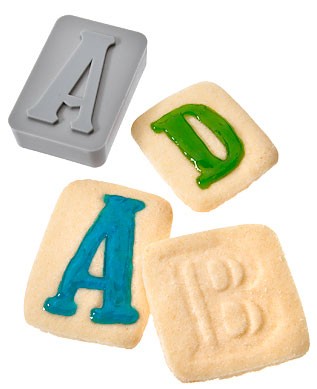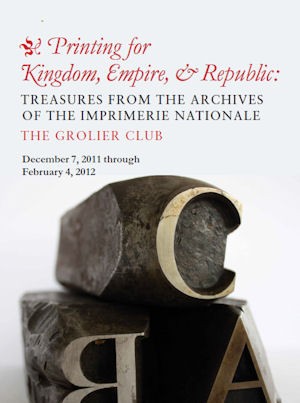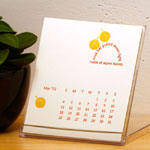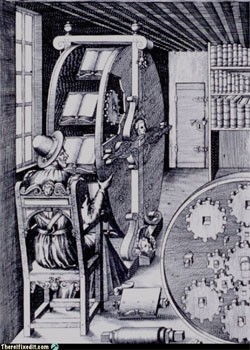
Check out these Letterpress type-style cookie cutters. The set even includes a “!” and “&” but unfortunately no “?”

Check out these Letterpress type-style cookie cutters. The set even includes a “!” and “&” but unfortunately no “?”
 There’s a really nice article about the current exhibit at the Grolier Club in NYC, “Printing for Kingdom, Empire & Republic: Treasures From the Archives of the Imprimerie Nationale.” Don’t miss the slide show of some great pictures of old type.
There’s a really nice article about the current exhibit at the Grolier Club in NYC, “Printing for Kingdom, Empire & Republic: Treasures From the Archives of the Imprimerie Nationale.” Don’t miss the slide show of some great pictures of old type.
A thing which is autotelic is described as “having a purpose in and not apart from itself”. It is a broad term that can be applied to missionaries, scientists, systems, and so forth…. Mihaly Csikszentmihalyi describes people who are internally driven, and as such may exhibit a sense of purpose and curiosity as autotelic. This determination is an exclusive difference from being externally driven, where things such as comfort, money, power, or fame are the motivating force.
My friend Lisa came to my rescue and we had a long conversation over lunch, puzzling out both words and the examples I had found. After more research, it seems that heterotelic/autotelic always go together, much like yin and yang. And while they are opposites, one is neither all good or all bad. Heterotelic is about external forces or pressures, autotelic is the internal ones. One looks outward, one looks inward. And as I thought about what sort of visual representation I would make, I kept coming back to the idea of balance between opposites. I found this quote from Euripides:
The best and safest thing is to keep a balance in your life, acknowledge the great powers around us and in us.
That balance is often hard to achieve, and my response to this week’s word is to express the struggle for balance with an animation encapsulated in a flipbook. Here’s a video of what I came up with:
The word for this week is, happily, less obscure: perspicacious, adj; Having keen mental perception and understanding; discerning.
 I just have a few left, and my 2012 calendar is on sale, now $17 + shipping. I just have a few left, and my 2012 calendar is on sale, now $17 + shipping. |
I’ve used this folding technique for my book Summer as well for a book I did as part of my on-going prompt challenge, shown in this blog post. David Rosen taught me this fold. He had instructions on his website, but they (and it) have disappeared.
![]() The photo above shows an example of the fold (an invitation to an exhibition of works by Julie Chen.)
The photo above shows an example of the fold (an invitation to an exhibition of works by Julie Chen.)
![]() Directions for the fold are here.
Directions for the fold are here.
UPDATE: Click here to see other posts on the Turkish Map Fold and its variations.
 Probably 90% of people who make New Year’s resolutions include “get more organized.” This may be the first January in quite some time that I didn’t try to “fix” some mess in my office and studio by rearranging things. Probably because I did a complete overhaul last September when I bought another set of paper drawers. But increasingly it’s information overload, not stuff, that’s a problem for me. Apparently this it’s a new problem, as reported by There I Fixed It, in a post called “Historical Thursday: Agostino Ramelli’s Bookwheel.” They say
Probably 90% of people who make New Year’s resolutions include “get more organized.” This may be the first January in quite some time that I didn’t try to “fix” some mess in my office and studio by rearranging things. Probably because I did a complete overhaul last September when I bought another set of paper drawers. But increasingly it’s information overload, not stuff, that’s a problem for me. Apparently this it’s a new problem, as reported by There I Fixed It, in a post called “Historical Thursday: Agostino Ramelli’s Bookwheel.” They say
The 16th century saw a similar wealth of knowledge increase. With the recent(ish) invention of the printing press, individuals now had access to a much wider variety of books and a fraction of the price. For the first time ever, it was viable for a person to have a library in their own home.
But imagine yourself back then attempting a research project. You want to learn about a topic from multiple sources and cross-reference each one. A desk with a scattered pile of books in no logical order with all sorts of bookmarks and notes trying to make sense of it all. Agostino Ramelli, an Italian engineer born in 1531 proposed a complex but intriguing solution to this problem; the bookwheel.
Based on the design of a waterwheel, the bookwheel would hold over a dozen separate titles, all sitting open at the same angle. Using either hand or foot controls, the reader could easily sort through the books he collected at ease without the fear of losing track of his place.
Read it all here. First seen on boing boing.